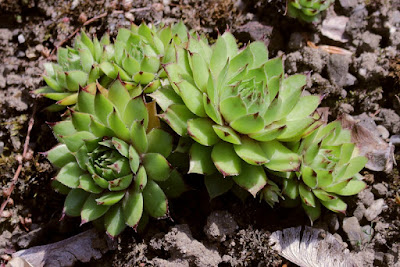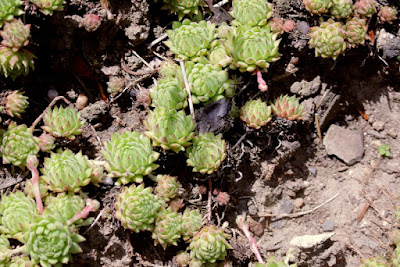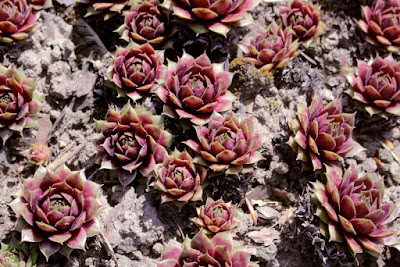Sempervivum marmoreum - Balkan Houseleek is very variable, especially in leaf color and indumentum. It can grow in USDA zones 4-9...
Sempervivum marmoreum, also called as Balkan Houseleek, Sempervivum assimile, Sempervivum balcanicum, Sempervivum ballii, Sempervivum banaticum, Sempervivum blandum, Sempervivum brunneifolium, Sempervivum degenianum, Sempervivum italicum, Sempervivum michaelis-borsii, Sempervivum ornatum, Sempervivum rubicundum, Sempervivum schlehanii, is a species of the genus Sempervivum. This species was described by August Heinrich Rudolf Grisebach in 1843.
IDENTIFY SEMPERVIVUM MARMOREUM - BALKAN HOUSELEEK
Sempervivum marmoreum is native to south-eastern Europe. It grows on rocky outcrops with southern exposure in Albania, Bulgaria, Czechoslovakia, Greece, Hungary, Italy, Romania, Ukraine, Yugoslavia at elevations of 250-2700 meters above sea level.
It is an evergreen perennial herb which grows as a rosette plant with a diameter of 3 to 10 cm and forms horizontal, finely downy-haired runners . The obovate to obovate-spatulate or broadly lanceolate, almost stalk-round leaves have a pointed tip or are briefly pointed. Young leaves on offshoots are very downy hairy.
Balkan Houseleek is very variable, especially in leaf color and indumentum, thereforethe following subspecies are sometimes distinguished: Sempervivum marmoreum subsp. marmoreum (Balkans, Romania); Sempervivum marmoreum subsp. blandum; Sempervivum marmoreum subsp. matricum (Hungary, Slovakia, Transylvania); Sempervivum marmoreum subsp. reginae-amaliae.
The downy-haired flowering shoot bears obovate or elongated to lanceolate, slightly pointed, upright leaves. The upright inflorescence usually consists of three forked coils. The lanceolate, pointed to pointed, reddish green, 5 to 6.5 mm long sepals are fused together over a length of up to 2.5 mm. The linear-lanceolate, pointed petals are red with whitish stripes near the edge. The stamens are bare. The stylus is about 2 mm long. The almost square to semicircular nectar flakes are greenish.
SEMPERVIVUM MARMOREUM - BALKAN HOUSELEEK CARE AND CULTURE
Cultural information should only be used as a guide, and should be to be adapted to suit you. Your physical location; where you grow your plants, how much time you have to devote to their care, and many other factors, will need to be taken into account. Only then can you decide on the cultural methods that best suit you and your plants.
Light:
Sempervivum marmoreum can tolerate a range of lighting conditions, from full sun to partially shaded with at least 4 hours of direct sunlight per day. If the plants grow outdoors, be sure to acclimate them to direct sunlight slowly, to avoid burning the leaves by making the transition too rapidly. While these plants can tolerate intense sun and intense heat, they perform the best when they are not subjected to both at the same time.
Temperature:
Balkan Houseleek can grow in USDA zones 4-9 and prefers summer temperature of 18-21 °C. In winter, they suffers the most during the frosts, and the effects will be noticeable only in the spring. The frozen leaves turn black and begin to rot. But it is necessary to note that after frost damage, the plants recover quickly.
In the winter, the care of the sempervivum is minimal, and you do not need to do anything special. However, there is something you still have to do to make overwintering easier: spray the plants with a fungicide (fungal diseases can develop even in winter, especially if there were no severe frosts), make sure that the soil does not contain much moisture to help the plant does not rot during the winter by add some small rubble to the soil, and do not cover or mulching these plants (cover the plant only increase the risk of disease).
Substrate and growing media:
Sempervivum marmoreum are commonly grown in containers (6 inch pots or larger), but you can grow them in bricks, driftwood and tufa rock, due to their ability to thrive in very little compost. South-facing rockeries, gravel gardens and vertical walls also make good habitats for these plants.
Good drainage is the most important requirement for the plant. Plant them in sandy soil or add compost, potting soil, gravel or vermiculite to the ground to help with drainage. They survive in soil where other plants can't grow. Ideally the soil pH level should be neutral, between 6.6 and 7.5.
Watering:
Adequate and consistent watering is essential during your plant's first year in the garden. Once established, the plants are very drought tolerant and require little watering. During the first summer, you may need to water as often as every few days in periods of drought and extreme summer heat. To determine if your plant needs water, dig a few inches into the soil next to the plant. If the soil is dry 2-3 inches below the surface, it is time to water. When the plant are mature, it is extremely drought hardy and thrive on infrequent but thorough watering - as little as once a month should be sufficient, in all but the hottest and driest of conditions. Plan to water even less as temperatures dip towards freezing to avoid leaving the roots in cold and soggy conditions, which can predispose plants to rot.
If you plant in a container, allow the top half of soil to dry out moderately between waterings. Water thoroughly until the soil is well-saturated and excess water flows through the drainage holes at the bottom of the container. Never allow the plants to sit in a saucer of water. Pots may be kept in saucers after any excess water has drained from the pot.
Fertilizer:
Feed your plants once every 2-3 weeks during the growing season with a water-soluble fertilizer. Discontinue feeding after September 1st so your plants can harden off for winter. Resume fertilizing when new growth appears in the spring.
Pruning:
Each central rosette produces new rosettes throughout its life cycle. As it approaches the end of its life cycle, the old rosette will stop making new rosettes and begin producing a flower spike from the center of the plant. Each rosette flowers when it reaches full maturity, then dies. Carefully remove the dead rosette after it has finished flowering. The new rosettes will quickly fill in the space and the cycle will continue. Remove the new rosettes and replant them if they become over-crowded.
Winter period:
Balkan Houseleek are incredibly hardy and do not require any special winter protection when planted in-ground. In very cold areas, containerized plants can be brought into an unheated, protected area such as a garage or cellar before temperatures drop below freezing. Check soil moisture every 2-3 weeks and water as needed during winter. In spring, containerized plants should be moved back out into the garden sunlight where they will begin to repeat their yearly garden performance.
Pests and diseases:
Keep the area around your plants free of weeds. Weeds compete with surrounding plants for food, water and light. Walk around the garden periodically and pull weeds, including the roots, as soon as you see them.
There are very few critters that eat the plant, for the most part of the year. In early spring, they are at risk from hungry deer or squirrels, who are eager for something delicious. The oddest pest is something you would never suspect, and they can clean out every last scrap, down to the roots. This unexpected predator is the wild turkey. Luckily, they're easy to combat with some chicken wire laid over top of the plants, or some bird cages.
Propagation:
Sempervivum marmoreum readily offset via stolons, or creeping stems, allowing these plants to quickly form a dense mat of foliage. As such, the easiest way to propagate these varieties is to gently lift an offset away from the parent plant, snip the stolon connecting the two, and replant the offset into porous soil in its own pot. Newly repotted offsets will require slightly more frequent watering as they establish their root system - but once growth is evident, revert to the more infrequent watering schedule preferred by mature plant.
BUY SEMPERVIVUM MARMOREUM - BALKAN HOUSELEEK AND RELATED PRODUCTS
BUY ANOTHERS SPECIES AND VARIETIES OF SEMPERVIVUM GENUS HERE!


















COMMENTS